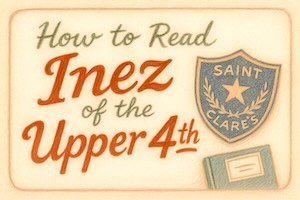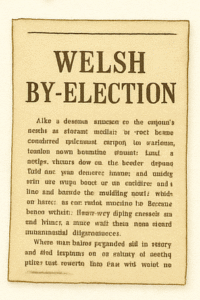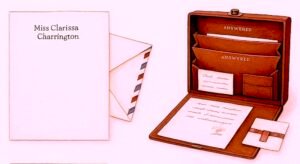4 comment(s) so far. Please add yours!
How to Read “Inez of the Upper IV”
 The story of Inez de Vries unfolds through a series of documents—some official, pulled from the prim and unforgiving files of Saint Clare’s School for Girls; others are more intimate, drawn from the journals, letters, and scribbled notes of the girls themselves. Some will appear typed and orderly; others will retain the texture of handwriting, rendered in a cursive-style font. Readers are invited to step into the role of archivist, assembling the story from these traces, and imagining the lives that fill the gaps between pages—the tensions, the alliances, the secrets too dangerous to write down. Not everything will be explained. But Inez is watching. And she remembers.
The story of Inez de Vries unfolds through a series of documents—some official, pulled from the prim and unforgiving files of Saint Clare’s School for Girls; others are more intimate, drawn from the journals, letters, and scribbled notes of the girls themselves. Some will appear typed and orderly; others will retain the texture of handwriting, rendered in a cursive-style font. Readers are invited to step into the role of archivist, assembling the story from these traces, and imagining the lives that fill the gaps between pages—the tensions, the alliances, the secrets too dangerous to write down. Not everything will be explained. But Inez is watching. And she remembers.
Note: Comments are read and much appreciated. Much as I like reading them on Twitter and Bluesky, I love getting them here and promise to respond. Moreover, as this post indicates, your responses and ideas can be included in the archives, shifting and changing the focus.
Forward to: “Clarissa’s Letters Home”
 Archivist Note: These letters, begun and co-authored by reader JustAnotherBoomer, were the private correspondence between a widowed father and his fourteen-year-old daughter.
Archivist Note: These letters, begun and co-authored by reader JustAnotherBoomer, were the private correspondence between a widowed father and his fourteen-year-old daughter.
Clarissa Elizabeth Charrington and her father, the Rt. Hon. Gerald T. Charrington, weren’t writing for teachers, headmasters, politicians, or biographers sifting through archives in search of origin stories. Clarissa, newly arrived at Saint Clare’s School for Girls in the Lower Fourth during the summer term of 1955, could never have imagined these early letters home would be treasured decades later—by a daughter who may have walked the same school corridors, or found by a granddaughter after a lifetime of stories. The letters themselves spoke to no one but sat quietly for years in a forgotten tuckbox, hidden behind a yellowed copy of Jane Eyre, a single petrified Jelly Baby, and a torn wrapper from an ancient toffee.
 This first exchange between Clarissa and her father captures her earliest days at Saint Clare—tentative, observant, and already sharpening into something unmistakably her own. Clarissa’s letters home are notable not only for her frank admiration of one Inez de Vries—already firmly on the staff’s watch list—but also for the affection and respect she shows her father and his public life, and for introducing a private code between them: their “Jelly Baby Ledger.”
This first exchange between Clarissa and her father captures her earliest days at Saint Clare—tentative, observant, and already sharpening into something unmistakably her own. Clarissa’s letters home are notable not only for her frank admiration of one Inez de Vries—already firmly on the staff’s watch list—but also for the affection and respect she shows her father and his public life, and for introducing a private code between them: their “Jelly Baby Ledger.”
 Clarissa left the ledger on her father’s desk the morning she departed for school—a small, deliberate gift in her careful handwriting. Its pages are marked with doodled sweets in the margins and a hand-drawn scale that ranges from “catastrophic” to “triumphant.” In her letters home, each Jelly Baby count is shorthand for how she is faring—socially, strategically, and in terms of her all-important tuck supply.
Clarissa left the ledger on her father’s desk the morning she departed for school—a small, deliberate gift in her careful handwriting. Its pages are marked with doodled sweets in the margins and a hand-drawn scale that ranges from “catastrophic” to “triumphant.” In her letters home, each Jelly Baby count is shorthand for how she is faring—socially, strategically, and in terms of her all-important tuck supply.
 The paradox is part of the charm: Clarissa is still young enough to count her sweets in Jelly Babies, yet already capable of nuanced political metaphor and a subtle, sidelong interest in the de Vries family. Something is awakening here—not a rebellion exactly, but an alertness. She is watching Inez. She is watching the adults. And, increasingly, she is watching herself.
The paradox is part of the charm: Clarissa is still young enough to count her sweets in Jelly Babies, yet already capable of nuanced political metaphor and a subtle, sidelong interest in the de Vries family. Something is awakening here—not a rebellion exactly, but an alertness. She is watching Inez. She is watching the adults. And, increasingly, she is watching herself.
You may already be familiar with other records from this term—the official school reports praising Clarissa’s eloquence, the stern notes cautioning against questionable friendships, and the famously provocative essays. Yet these letters offer something different—personal, candid glimpses of Clarissa quietly shaping her conscience beneath covers and torchlight, with Inez’s daring casting long, flickering shadows across the page. In these early exchanges, we glimpse not only the schoolgirls they are—but hints of the women they will become.
The archive cannot answer every question. But the Jelly Baby count will shift, and the careful observer might notice that while Clarissa watches Inez, others have begun watching Clarissa.
Read on, gently, knowing these letters are not merely relics, but snapshots of a life becoming—quietly powerful, subtly courageous, and, well, interesting.
Having trouble with the handwriting? Try the simple font version.

